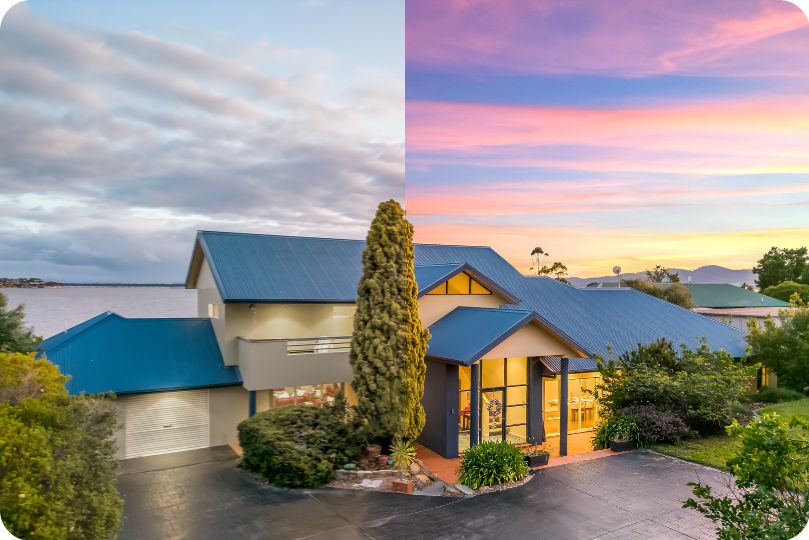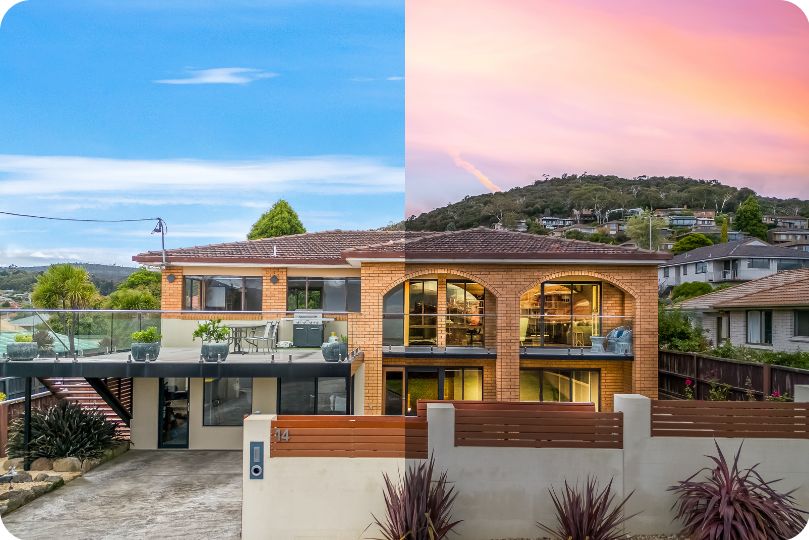Mastering Real Estate Twilight Photography: Tips for Captivating Listings
In the ever-evolving landscape of real estate marketing, one thing remains constant: the need to capture attention and leave a lasting impression. Amid the plethora of techniques vying for prominence, there’s a hidden gem that has the power to not only captivate but also elevate your property listings to a realm of unparalleled allure. We’re talking about none other than the enchanting world of real estate twilight photography.
Picture this: the sun, in its slow descent beyond the horizon, casts a warm and golden hue that delicately embraces your property. Shadows lengthen, architectural details come alive, and a sense of enchantment fills the air. As the natural light seamlessly melds with the soft glow of artificial illumination, your property transforms into a realm of ethereal beauty that’s simply irresistible.
In the following pages, we’re about to unlock the secrets that lie within this twilight realm. We’ll delve into the art and science of real estate twilight photography, unveiling a treasure trove of tips and techniques that will set your listings apart. By harnessing the enchanting transition between day and night, you have the chance to not only showcase a property but to paint a vivid story of a lifestyle waiting to be embraced.
Through the lens of twilight photography, your properties will transcend the ordinary, casting a spell on potential buyers as they scroll through listings. Every image becomes a visual narrative, a promise of warm evenings and tranquil mornings, a testament to the unique character of each property.
Quick Tips
Understanding Real Estate Twilight Photography
Real Estate twilight photography refers to capturing images during the “twilight” hours, which are the periods just before sunrise and just after sunset. These moments offer a unique blend of natural and artificial lighting that can transform a property’s appearance. There are three phases of twilight: civil, nautical, and astronomical, each with its distinct lighting characteristics. Civil twilight occurs shortly after sunset or just before sunrise, providing a soft, even light that’s ideal for creating warm, inviting interiors. Nautical and astronomical twilight follow, introducing deeper blues and the sparkle of stars, enhancing exterior shots.
Essential Equipment

To embark on your twilight photography journey, you’ll need the right equipment. A digital single-lens reflex (DSLR) or mirrorless camera is essential for its manual controls and high-quality sensors. Pair it with a wide-angle lens to capture expansive interiors and showcase outdoor spaces effectively. A sturdy tripod is non-negotiable for the long exposure times demanded by twilight photography. Additionally, consider using external flashes or continuous lighting to balance ambient and artificial light sources for optimal results.
Planning and Preparation
Successful twilight photography requires meticulous planning. Scout the location during daylight hours to identify the best angles and features to highlight. Consider the orientation of the property and its relationship to the setting sun. Choose the ideal time to start shooting based on the specific phase of twilight you’re aiming for. This planning will enable you to efficiently set up your gear and make the most of the limited shooting window.
Setting Up the Scene
Create an inviting ambiance by staging the property’s interior and exterior. Arrange furniture and decor to maximize the feeling of space and comfort. Outdoors, incorporate warm lighting elements like pathway lights and pool lights to draw attention to key areas. This staging adds depth and character to your twilight shots, making them more engaging to potential buyers.
Camera Settings for Twilight Photography
Camera settings play a pivotal role in capturing stunning twilight photographs. Start with a low ISO setting to minimize noise and maintain image quality. To obtain a narrow depth of field, choose a wide aperture (lower f-stop number), blurring the background and emphasising focal points. As twilight scenes can vary greatly in contrast, bracketing—capturing multiple shots at different exposures—will help you blend images later for a balanced final result.
Golden Hour Magic
The “golden hour” within twilight, occurring shortly after sunset or before sunrise, offers soft, warm lighting that can make your images truly enchanting. This magical light enhances architectural details, casts inviting glows, and evokes a sense of coziness. Capitalize on this short-lived window to capture interiors bathed in a warm, welcoming glow and exterior shots painted in soft hues.
Incorporating Artificial Lighting
Combining natural twilight light with artificial lighting sources can yield exceptional results. When shooting interiors, turn on indoor lights to create an inviting atmosphere. External flashes can help illuminate darker areas without overpowering the ambient light. Use the “painting with light” technique to guide the viewer’s eye to specific features by selectively illuminating them.

Editing and Post-Processing
Post-processing is a vital step in perfecting your twilight images. Use photo editing software to adjust white balance, enhance colors, and fine-tune exposure. Carefully balance the interior and exterior lighting to ensure a natural, pleasing blend. Pay attention to details like removing distracting elements or correcting minor imperfections. The goal is to create a polished image that accurately represents the property’s beauty.
Showcasing Twilight Photos
Once you’ve captured and edited your twilight shots, it’s time to showcase them effectively. Incorporate these images into your property listings, websites, and marketing materials. Twilight photos have a way of grabbing attention and leaving a lasting impression on potential buyers. Utilize these images strategically to highlight unique selling points and create an emotional connection with viewers.
Mistakes to Avoid : Navigating Twilight Photography Pitfalls
Embarking on the journey of real estate twilight photography brings with it a unique set of challenges to overcome. Just as the transition from day to night is nuanced, so too are the potential pitfalls that can arise. By being aware of these stumbling blocks, you can navigate the twilight landscape with confidence and finesse. Here are key missteps to avoid, ensuring your twilight images shine as brilliantly as the fading sun.
1. Overexposure Dilemma
One of the most common missteps in twilight photography is falling prey to overexposure. As you seek to capture the delicate balance between natural and artificial light, it’s easy to let the highlights blow out, resulting in loss of detail. Keep a watchful eye on your camera’s histogram, ensuring it doesn’t lean heavily to the right. This caution will safeguard the integrity of your images, allowing intricate details to shine through.
2. Tangled in Tints
The interplay of diverse light sources during twilight can lead to an unwanted color cast in your images. Mixed lighting—such as the warm glow of indoor lamps contrasting with the cool evening sky—can result in a discordant color palette. To avoid this, consider adjusting the white balance during post-processing. Balancing warm and cool tones will harmonize your images, creating a visually pleasing and natural result.
3. Composition Chaos
Even amidst the enchantment of twilight, poor composition can diminish the impact of your images. Avoid cluttered scenes and distracting elements that draw attention away from the property’s focal points. Opt for clean and balanced compositions that guide the viewer’s gaze through the frame, highlighting the architectural details and features you want to emphasize.
4. Neglecting Twilight’s Essence
While artificial lighting is a powerful tool in twilight photography, remember that the essence of twilight lies in its balance between day and night. Over-illuminating the scene can lead to images that lack the magic inherent in the transition. Aim to strike a harmonious equilibrium where the soft, fading daylight seamlessly blends with the warm glow of indoor lights, preserving the enchanting atmosphere of twilight.
5. Disregarding Privacy and Permissions
Amid the creative process, it’s essential to remain respectful of privacy and permissions. Always secure the homeowner’s consent before capturing their property, especially during twilight hours. Avoid unintentionally capturing sensitive areas that could breach their privacy. By maintaining ethical practices, you uphold the integrity of your work and establish trust with clients.

Legal and Ethical Considerations
It’s essential to adhere to moral and legal requirements when taking twilight photographs. Always obtain permission from homeowners before photographing their property, especially during twilight hours. Be mindful of privacy concerns, avoiding capturing sensitive areas that could infringe on a homeowner’s privacy.
Conclusion
As the sun bids its daily farewell, the realm of real estate twilight photography unveils its captivating allure for real estate marketing. Armed with the wisdom shared in this article, you’re primed to harness the interplay of natural and artificial light to craft mesmerizing images that evoke emotion and curiosity. Twilight’s delicate balance holds the power to elevate your listings, capturing not just properties but the dreams they embody.
By planning meticulously, mastering exposure, and weaving an enchanting narrative through images, you invite potential buyers to step into a world suffused with warmth, elegance, and aspiration. As the twilight hours unfold, you stand as both photographer and storyteller, inviting viewers to imagine the life they could live within the spaces you so artfully portray.
